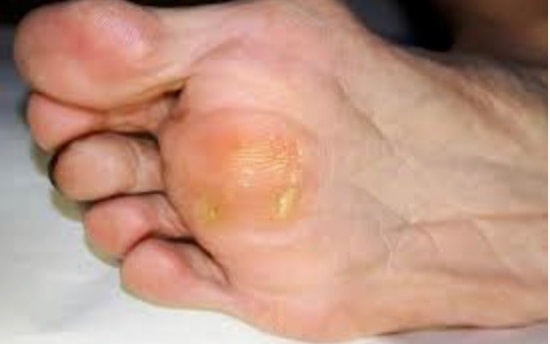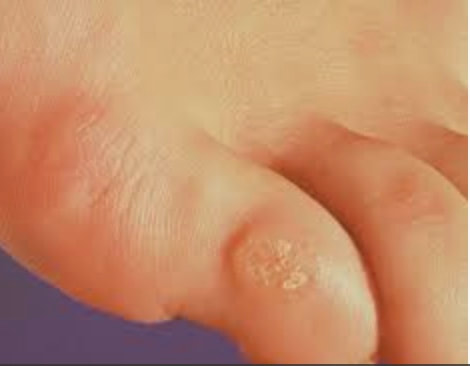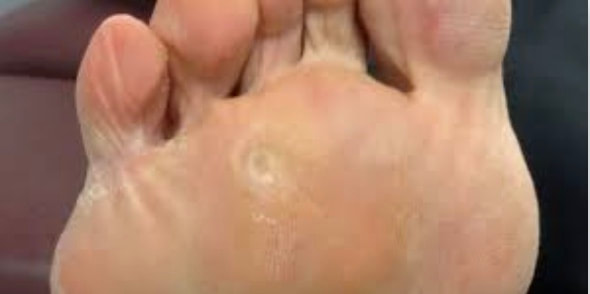CORNS AND CALLOUSES
Corns and calluses are your body's response to friction or pressure against the skin If your foot rubs inside your shoes, the affected area of skin thickens. Or if a bone is not in the normal position, skin caught between bone and shoe or bone and ground builds up. In either case, the outer layer of skin thickens to protect the foot from unusual pressure. In many cases, corns and calluses look bad but are not harmful. However, more severe corns and calluses can be controlled.
Where Do Corns & Calluses Form? A corn or callus is a thickening of the outer layer of skin on your foot. Corns usually grow on top of the foot, often at a toe joint. Calluses spread on the bottom of the foot or the outer edge of a toe or the heel.
CornsCorns can range from a slight thickening of skin to a painful, hard bump. They often form on top of buckled toe joints (hammer toes). If your toes curl under, corns may grow on the tips of the toes. You may also get a corn on the end of a toe if it rubs against your shoe. Corns can also grow between toes, often between the first and second toes.
CallusesA callus may spread across the ball of your foot. This type of callus is usually due to a problem with a metatarsal (the long bone at the base of a toe, near the ball of the foot). A pinch callus may grow along the outer edge of the heel of the big toe. Some calluses press up into the foot instead of spreading on the outside. A callus may form a central core or plug of tissue where pressure is greatest.
Your Physical ExamDr. Karr will check your feet for skin changes, such as read areas, blisters, and warts. He will also look for corns and calluses. If you have a buckled toe joint, your doctor may test its flexibility. He may also look for a misaligned bone or collapsed joint. An x-ray may be taken to pinpoint a suspected bone problem.
Treating Corns & CallusesIf your corns or calluses are mild, reducing friction may help. Different shoes, moleskin patches, or soft pads may be all the treatment you need. In more severe cases, treating tissue buildup may require Dr. Karr's care. Sometimes orthotics (custom-made shoe inserts) are prescribed to reduce friction and pressure.
Change ShoesIf you have corns, your doctor may suggest wearing shoes that have more toe room. This way, buckled joints are less likely to be pinched against the top of the shoe. If you have calluses, wearing a cushioned insole, arch support, or heel counter can help reduce friction.
Visit Your PodiatristIn some cases, your doctor may trim away the outer layers of skin that make up the corn or callus. For a painful corn, medication may be injected beneath the built-up tissue.
Wear OrthoticsOrthotics (or Orthoses) are specially made to meet the needs of your feet. They cushion calluses or divert pressure away from the se problem areas. Worn as directed, orthotics help limit existing problems and prevent new ones from forming.
Corns and calluses are your body's response to friction or pressure against the skin If your foot rubs inside your shoes, the affected area of skin thickens. Or if a bone is not in the normal position, skin caught between bone and shoe or bone and ground builds up. In either case, the outer layer of skin thickens to protect the foot from unusual pressure. In many cases, corns and calluses look bad but are not harmful. However, more severe corns and calluses can be controlled.
Where Do Corns & Calluses Form? A corn or callus is a thickening of the outer layer of skin on your foot. Corns usually grow on top of the foot, often at a toe joint. Calluses spread on the bottom of the foot or the outer edge of a toe or the heel.
CornsCorns can range from a slight thickening of skin to a painful, hard bump. They often form on top of buckled toe joints (hammer toes). If your toes curl under, corns may grow on the tips of the toes. You may also get a corn on the end of a toe if it rubs against your shoe. Corns can also grow between toes, often between the first and second toes.
CallusesA callus may spread across the ball of your foot. This type of callus is usually due to a problem with a metatarsal (the long bone at the base of a toe, near the ball of the foot). A pinch callus may grow along the outer edge of the heel of the big toe. Some calluses press up into the foot instead of spreading on the outside. A callus may form a central core or plug of tissue where pressure is greatest.
Your Physical ExamDr. Karr will check your feet for skin changes, such as read areas, blisters, and warts. He will also look for corns and calluses. If you have a buckled toe joint, your doctor may test its flexibility. He may also look for a misaligned bone or collapsed joint. An x-ray may be taken to pinpoint a suspected bone problem.
Treating Corns & CallusesIf your corns or calluses are mild, reducing friction may help. Different shoes, moleskin patches, or soft pads may be all the treatment you need. In more severe cases, treating tissue buildup may require Dr. Karr's care. Sometimes orthotics (custom-made shoe inserts) are prescribed to reduce friction and pressure.
Change ShoesIf you have corns, your doctor may suggest wearing shoes that have more toe room. This way, buckled joints are less likely to be pinched against the top of the shoe. If you have calluses, wearing a cushioned insole, arch support, or heel counter can help reduce friction.
Visit Your PodiatristIn some cases, your doctor may trim away the outer layers of skin that make up the corn or callus. For a painful corn, medication may be injected beneath the built-up tissue.
Wear OrthoticsOrthotics (or Orthoses) are specially made to meet the needs of your feet. They cushion calluses or divert pressure away from the se problem areas. Worn as directed, orthotics help limit existing problems and prevent new ones from forming.



